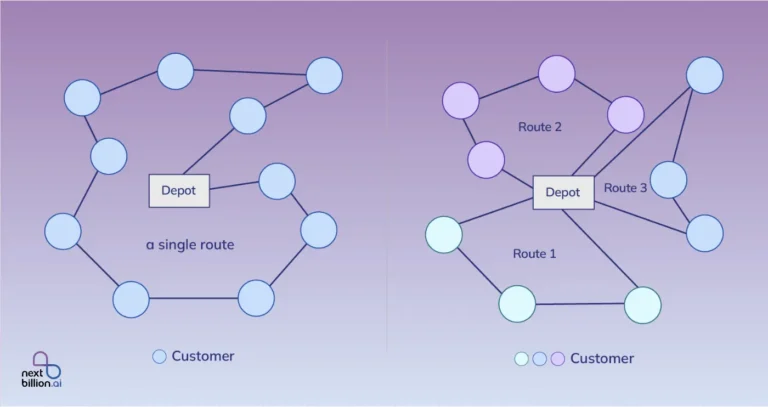
Table of Contents
Machine learning in route optimization algorithms is revolutionizing the fast-paced world of logistics. Every mile and minute shaved off a delivery route translates directly into cost savings, increased customer satisfaction, and a stronger competitive edge.
With the advent of machine learning, the possibilities for enhancing route optimization have expanded significantly. Complex algorithms and vast datasets enable businesses to navigate intricate logistics networks with unprecedented accuracy and foresight.
This article dives into the transformative role of machine learning in route optimization, exploring its benefits, underlying algorithms, and future trends.
Understanding Machine Learning in Route Optimization
Machine learning, a subset of artificial intelligence (AI), empowers logistics professionals to extract insights from historical transportation data, predict future demand shifts, and adjust routes in real-time. These algorithms are dynamic, continuously learning and evolving from new data, thus refining their recommendations over time. The goal is multifaceted: to improve fuel efficiency, reduce travel time, and optimize vehicle loads.
Machine learning algorithms analyze vast amounts of data to identify patterns and make predictions. In the context of route optimization, they consider various factors such as traffic conditions, weather patterns, vehicle capacities, and delivery priorities. By processing this data in real-time, ML models can dynamically adjust routes to ensure optimal performance, even in rapidly changing environments.
Key Benefits of Machine Learning in Route Optimization
Automatic Adaptability
One of the most significant advantages of machine learning algorithms is their ability to adapt automatically. Unlike traditional methods that rely on static rules, ML algorithms adjust routes based on real-time information. This adaptability is crucial in logistics, where traffic conditions, delivery priorities, and other variables can change quickly. For instance, if an accident causes a traffic jam, the algorithm can reroute deliveries to avoid delays, ensuring that the logistics network remains efficient.
Predictive Knowledge
Machine learning models excel at predictive analytics. By analyzing historical data and external factors, these models can forecast future demand patterns and traffic conditions. This predictive capability allows for more efficient route planning and resource allocation. For example, an ML model might predict increased demand for deliveries in a particular area due to an upcoming event, allowing the logistics company to allocate additional resources proactively.
Handling Complexity
Logistics networks are inherently complex, with numerous variables and constraints to consider. Machine learning algorithms are well-suited to handle this complexity. They can solve multidimensional optimization problems quickly and accurately, taking into account factors such as vehicle capacity, delivery windows, and traffic conditions. This ability to manage complexity is particularly valuable in large-scale logistics operations, where traditional methods may fall short.
Continuous Improvement
Machine learning algorithms are designed to learn from experience. Through iterative learning and feedback loops, these algorithms continuously refine their strategies. This process of continuous improvement ensures that the algorithms become more efficient and effective over time. For instance, an ML algorithm might initially make suboptimal route recommendations, but as it processes more data and receives feedback, it will improve its accuracy and efficiency.
What Are Route Optimization Algorithms?
Route optimization algorithms are computational methods used to determine the most efficient delivery routes. They are a vital link in the supply chain, ensuring both business profitability and effective delivery. These algorithms take into account a wide range of variables, including traffic conditions, vehicle capacity, weather, and more. By optimizing routes, these algorithms help reduce operational costs, lower carbon emissions, and improve overall service quality.
Types of Route Optimization Algorithms
Route optimization algorithms can range from simple to highly complex, each with varying computational times and levels of service quality. Here, we explore some of the most common types of algorithms used in route optimization.
Dijkstra’s Algorithm
Dijkstra’s Algorithm is a fundamental algorithm for finding the shortest path between nodes in a graph. It is widely used in GPS navigation systems and other applications where determining the shortest distance or time between two points is essential. The algorithm works by iteratively selecting the node with the smallest tentative distance from the source and updating the distances of its neighboring nodes. Despite its simplicity, Dijkstra’s Algorithm is highly effective and forms the basis for more complex algorithms.
Bellman-Ford Algorithm
The Bellman-Ford Algorithm is similar to Dijkstra’s Algorithm but can handle graphs with negative weight edges. This capability makes it suitable for scenarios where some routes may have negative weights. While Bellman-Ford is generally slower than Dijkstra’s Algorithm, it is still useful for specific route optimization problems. However, its slower speed makes it less appropriate for real-time applications.
Floyd-Warshall Algorithm
The Floyd-Warshall Algorithm is another well-known method for finding shortest paths in a weighted graph. Unlike Dijkstra’s Algorithm, Floyd-Warshall can handle graphs with positive or negative edge weights, as long as there are no negative cycles. This algorithm is particularly useful for applications where the goal is to determine the shortest paths between all pairs of nodes in the graph.
A* Search Algorithm
The A* Search Algorithm is a popular heuristic-based search algorithm for pathfinding and route optimization. It combines the benefits of Dijkstra’s Algorithm and breadth-first search by using heuristics to estimate the cost of traveling to the destination from each node. A* can quickly find the best paths while considering traffic conditions, making it especially useful in real-time applications like GPS navigation.
Vehicle Routing Problem (VRP) Solvers
The Vehicle Routing Problem (VRP) is a classic problem in logistics that involves determining the optimal routes for multiple vehicles to visit a set of locations under various constraints. VRP solvers use specialized algorithms to address this problem, taking into account constraints such as road restrictions, driver working hours, delivery windows, and vehicle capacity. There are many types of VRP solvers, including exact algorithms like branch-and-bound and metaheuristic methods like simulated annealing and genetic algorithms.
Factors to Consider in Choosing Route Optimization Algorithms
When selecting a route optimization algorithm, several factors must be considered to ensure it meets the specific needs of the logistics operation. Here are some critical considerations:
Real-Time Traffic Considerations
Traffic congestion is a significant challenge in logistics. According to a study, traffic jams cost the U.S. economy $305 billion in 2017. Incorporating real-time traffic data into route optimization algorithms can significantly reduce logistics costs, ensure timely deliveries, and improve adherence to service level agreements (SLAs). The best software for businesses uses dynamic, real-time data to plan routes and calculate estimated times of arrival (ETAs).
Order-Vehicle Constraints
Effective route optimization software must account for real-life constraints, such as order-vehicle compatibility. For example, certain types of goods, like perishable food and electronics, cannot be shipped together. Additionally, some goods, such as pharmaceuticals, may require specific types of vehicles for transportation. Software that considers these constraints is more likely to provide practical and efficient routing solutions.
Accurate Geocoding
Geocoding is the process of converting addresses into precise latitude and longitude coordinates. Accurate geocoding is essential for effective route optimization. The ability to interpret unclear addresses and understand local geography can significantly impact routing accuracy. A comprehensive list of local addresses and apartment locations is also beneficial for precise geocoding.
Historical Data Analysis
Route planning software should leverage historical data to inform current decisions. Analyzing past data on riders, customers, and traffic patterns can provide valuable insights. For instance, a rider’s past performance can indicate their expertise, preferred delivery times, and familiar work areas. Similarly, customer data can reveal preferred delivery times and special instructions. Historical traffic data can highlight congestion patterns and opening hours of specific buildings. Incorporating these insights can enhance route planning accuracy.
Consideration of Rider Preference
One of the significant challenges in implementing routing plans is gaining acceptance from ground operations teams. These teams often have established ways of working, and introducing new systems can be disruptive. Effective software should solicit input from ground teams to ensure smoother implementation. Instead of overhauling existing processes entirely, gradual integration of new routing plans can help gain acceptance and improve efficiency.
Management of Change
Transitioning to new route optimization software can be challenging, especially if the ground team is resistant to change. Providing on-site experts and training modules can facilitate this transition. Incentives and success stories from other businesses can also motivate the team to adopt the new system. Effective change management strategies are crucial for successful implementation.
Analytics and Report Management
Comprehensive route optimization software should offer robust analytics and reporting capabilities. Centralized monitoring and management of operations are essential for comparing performance across different business hubs. The software should provide insights into actual vs. planned routes, enabling managers to identify areas for improvement. A unified dashboard that offers a holistic view of operations can enhance decision-making and operational efficiency.
Dynamic Route Planning
The ability to handle both scheduled and on-demand orders is increasingly important in logistics. Businesses need software that can adapt to changing conditions and reroute deliveries in real-time. For instance, if a customer’s order or preferences change while a rider is en route, the software should dynamically adjust the route to accommodate the new requirements. This flexibility is crucial for maintaining high levels of customer satisfaction and operational efficiency.
Future Trends and Developments
The field of route optimization is continually evolving, driven by advancements in AI and machine learning. Here are some future trends and developments to watch:
Multi-Modal Transportation
AI-powered route optimization will enable seamless integration of various transportation modes, such as buses, trains, subways, and ride-sharing services. This integration will provide users with comprehensive and efficient travel options, reducing overall travel time and enhancing convenience.
Smart Cities
AI-driven traffic management systems will play a crucial role in developing smart cities. These systems will optimize traffic flow, reduce congestion, and minimize pollution. By prioritizing eco-friendly and public transportation, AI will contribute to more sustainable urban environments.
Enhanced User Experience
AI will enhance the user experience by providing personalized recommendations for routes, travel times, and transportation modes. Voice-controlled AI assistants will guide travelers throughout their journeys, making travel more convenient and enjoyable.
Safety Prioritization
AI-driven route optimization will prioritize safety across various industries, including transportation, mining, and construction. By selecting safe routes, reducing accident risks, and monitoring driver behavior, AI will contribute to safer working environments and improved overall safety.
Sustainability
AI and ML will play a vital role in reducing the environmental impact of transportation. By optimizing routes for minimal pollution and efficient fuel use, these technologies will support eco-friendly transportation practices. AI will also promote the adoption of electric and hybrid vehicles, further reducing the carbon footprint of logistics operations.
Wrapping Up
Machine learning has transformed the field of route optimization, offering numerous benefits across various industries. From automatic adaptability and predictive knowledge to handling complexity and continuous improvement, ML algorithms have revolutionized logistics. By incorporating real-time traffic considerations, order-vehicle constraints, accurate geocoding, historical data analysis, and rider preferences, businesses can optimize their routes for efficiency and customer satisfaction.
As the field continues to evolve, future trends such as multi-modal transportation, smart cities, enhanced user experiences, safety prioritization, and sustainability will further enhance the impact of machine learning on route optimization. By leveraging these technologies, businesses can stay ahead of the competition, reduce costs, and contribute to a more sustainable future.
About Author
Rishabh Singh
Rishabh Singh is a Freelance Technical Writer at NextBillion.ai. He specializes in Programming, Data analytics and technical consulting, turning complex tech into clear and engaging content.
Ready to get started?
Related FAQs
Route optimization algorithms help businesses reduce transportation costs, optimize delivery times, and lower fuel consumption. These benefits ultimately enhance customer satisfaction and operational efficiency.
While no algorithm can guarantee complete accuracy due to unpredictable variables, modern algorithms like A* search and VRP solvers provide nearly optimal solutions. These algorithms iency and reduce travel time.
Route optimization algorithms consider various factors, including traffic conditions, vehicle capacity, weather, and delivery priorities. By analyzing these factors, they determine the best routes for deliveries and vehicles.







